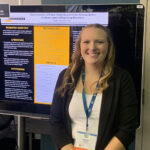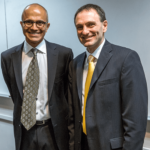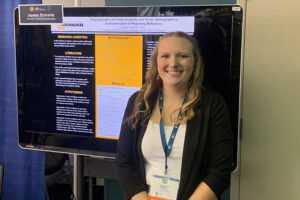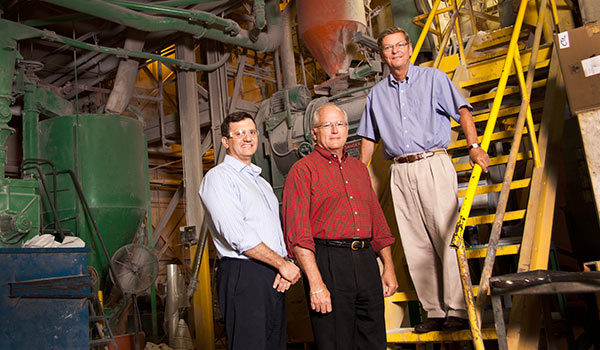
During a recent visit by Chinese companies substantially larger than his, Jef Butterfield, president of Gossen Corporation, realized what it takes for mid-sized and smaller American companies to compete in the global marketplace.
Despite their lower labor costs, Chinese operations he encountered weren’t nearly as well-organized or efficient as the Glendale-based Gossen plant that produces extruded plastic and PVC building materials and decking.
And Butterfield credits this advantage to his 14-year relationship with an engineer at the University of Wisconsin-Milwaukee (UWM) and a legion of engineering student-workers.
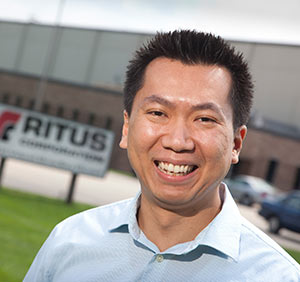
What began as a quest to procure the right kind of raw materials from vendors became an ongoing relationship aimed at continuous process improvement.
“I had charted a direction, but I couldn’t identify all the details,” says Butterfield. “That’s where the university helped us.”
Searching for best practices
In the beginning, Butterfield needed someone with the expertise to communicate the company’s processes and needs to vendors making the company’s raw materials.
Answering the call was Nidal Abu-Zahra, who is now an associate professor and current chair of the Materials Department in UWM’s College of Engineering & Applied Science (CEAS). Abu-Zahra helped the company start its own materials research and development arm, which currently is run by Hong Chang, a UWM adjunct instructor.
In return, the company set up an onsite laboratory for Abu-Zahra, with 24-hour access and equipment he didn’t have at UWM.
Abu-Zahra brought in graduate students to help conduct the materials research. In fact, eight of his graduate students did their entire master’s theses or doctoral dissertations from their work at Gossen.
Students are now involved in all aspects of Gossen’s business, from collecting data to identifying cost-control strategies like recycling.
Mehdi Ghaffarisarghein was a doctoral student working at Gossen in 2010.
“If a problem with a product arose, then the blame game would begin,” says Abu-Zahra. “That’s when we would ask Medhi to dissect the material and do the analysis that would prove whether a vendor was at fault.” Often, professor and student had to face the vendor in the presence of Gossen management to make their case.
In addition to guidance in materials, Abu-Zahra and Butterfield embarked on a comprehensive overhaul of the company’s manufacturing practices, focusing on efficiencies.
Abu-Zahra helped create value streams within the plant by rearranging how the processes were laid out and accomplished on the floor. He helped improve monitoring of the production lines’ actual costs, and found ways to expedite both the extrusion and cooling processes.
“It ends up becoming an evolution,” says Butterfield of process improvement. “Each time you do something, it opens up a whole new layer to work on.”
An army of students
Through it all, Abu-Zahra brought in a steady stream of UWM students, including undergraduates, to join in finding that lean manufacturing sweet spot.
“The students’ role is to carry out the details,” says Abu-Zahra. “My goal is to teach them initiative, and there’s plenty of opportunity for that in a smaller company.”
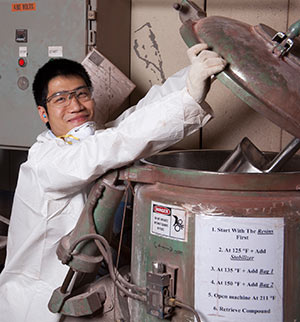
Aris Soetedjo was a junior when Abu-Zahra recruited him to work at Gossen.
“Before working there, I had no clue what a job in manufacturing would be like,” says Soetedjo, a UWM alumnus who is now an engineer at Ritus Corp.
An average student in the classroom, Soetedjo thrived in the applied opportunities at Gossen, working on everything from quality control to inventory – even driving a forklift. He also created a custom bar-scanning system with accompanying software.
“I am the kind of person who is hands-on,” says Soetedjo. “In this size company, one person does a variety of things.”
Since 2000, Gossen interns from UWM have numbered nearly 30, with most graduates now working in the plastics industry.
“The plastics sector constitutes a large industrial cluster in Southeastern Wisconsin,” says Mike Krauski, CEAS director of corporate relations. “At UWM, we’re making sure the educational and research resources are available. For example, CEAS recently added injection molding equipment.”
A metamorphosis
Students are now involved in all aspects of Gossen’s business, from collecting data to identifying cost-control strategies like recycling. Changes in processes necessitated education of Gossen employees, and students were even involved in rewriting the training manuals.
Today, the efforts have paid off. The company’s plant in Cartersville, Ga., has documented a 400% increase in efficiency in only the last year. Parts of the Glendale operation are similarly improved.
The cumulative efficiencies have leveled the playing field for Gossen as it competes with Chinese companies that have cheaper labor costs. “On some products – weather stripping, for example – we’re just as competitive as what we were seeing in China.”
The UWM partnership has given Butterfield and COO John Green a better understanding of the importance of supplying “niche” products, while they can outsource raw materials from foreign suppliers.
“Now we’re on the completely right path,” Butterfield says. “Today, we need fewer lines to run the same order. That’s the throughput effect.”
